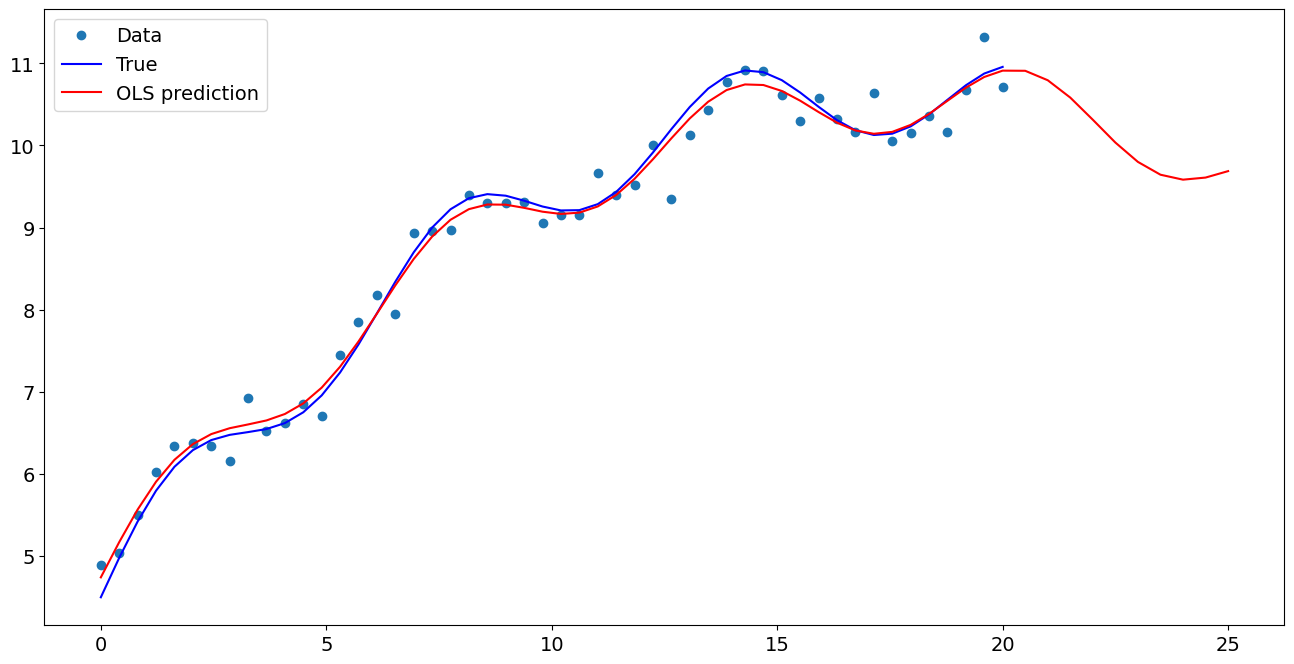Prediction (out of sample)¶
[1]:
%matplotlib inline
[2]:
import numpy as np
import matplotlib.pyplot as plt
import statsmodels.api as sm
plt.rc("figure", figsize=(16, 8))
plt.rc("font", size=14)
Artificial data¶
[3]:
nsample = 50
sig = 0.25
x1 = np.linspace(0, 20, nsample)
X = np.column_stack((x1, np.sin(x1), (x1 - 5) ** 2))
X = sm.add_constant(X)
beta = [5.0, 0.5, 0.5, -0.02]
y_true = np.dot(X, beta)
y = y_true + sig * np.random.normal(size=nsample)
Estimation¶
[4]:
olsmod = sm.OLS(y, X)
olsres = olsmod.fit()
print(olsres.summary())
OLS Regression Results
==============================================================================
Dep. Variable: y R-squared: 0.989
Model: OLS Adj. R-squared: 0.988
Method: Least Squares F-statistic: 1387.
Date: Tue, 01 Apr 2025 Prob (F-statistic): 4.30e-45
Time: 13:58:28 Log-Likelihood: 11.801
No. Observations: 50 AIC: -15.60
Df Residuals: 46 BIC: -7.954
Df Model: 3
Covariance Type: nonrobust
==============================================================================
coef std err t P>|t| [0.025 0.975]
------------------------------------------------------------------------------
const 5.0013 0.068 73.648 0.000 4.865 5.138
x1 0.5077 0.010 48.479 0.000 0.487 0.529
x2 0.4127 0.041 10.023 0.000 0.330 0.496
x3 -0.0216 0.001 -23.438 0.000 -0.023 -0.020
==============================================================================
Omnibus: 1.135 Durbin-Watson: 1.972
Prob(Omnibus): 0.567 Jarque-Bera (JB): 0.941
Skew: -0.031 Prob(JB): 0.625
Kurtosis: 2.331 Cond. No. 221.
==============================================================================
Notes:
[1] Standard Errors assume that the covariance matrix of the errors is correctly specified.
In-sample prediction¶
[5]:
ypred = olsres.predict(X)
print(ypred)
[ 4.46247807 4.91789328 5.33921539 5.70395387 5.9977349 6.21666297
6.36796086 6.468783 6.54339699 6.61919658 6.72220087 6.87277952
7.08230601 7.35128905 7.669289 8.01663304 8.36764739 8.69487544
8.97358876 9.18584996 9.3234597 9.38930386 9.39687939 9.36807678
9.32958353 9.30849946 9.3278843 9.40296904 9.53865349 9.72870132
9.95676459 10.19906974 10.42832347 10.618197 10.74765177 10.80439602
10.78690432 10.70466818 10.57663661 10.42810287 10.28654884 10.17712984
10.11854168 10.11994897 10.17947945 10.28453154 10.41384477 10.54099283
10.63872532 10.6834449 ]
Create a new sample of explanatory variables Xnew, predict and plot¶
[6]:
x1n = np.linspace(20.5, 25, 10)
Xnew = np.column_stack((x1n, np.sin(x1n), (x1n - 5) ** 2))
Xnew = sm.add_constant(Xnew)
ynewpred = olsres.predict(Xnew) # predict out of sample
print(ynewpred)
[10.64325958 10.49158089 10.24459247 9.93917475 9.62387534 9.34702292
9.14489465 9.03283427 9.00149543 9.01912998]
Plot comparison¶
[7]:
import matplotlib.pyplot as plt
fig, ax = plt.subplots()
ax.plot(x1, y, "o", label="Data")
ax.plot(x1, y_true, "b-", label="True")
ax.plot(np.hstack((x1, x1n)), np.hstack((ypred, ynewpred)), "r", label="OLS prediction")
ax.legend(loc="best")
[7]:
<matplotlib.legend.Legend at 0x7f6c4cafc130>

Predicting with Formulas¶
Using formulas can make both estimation and prediction a lot easier
[8]:
from statsmodels.formula.api import ols
data = {"x1": x1, "y": y}
res = ols("y ~ x1 + np.sin(x1) + I((x1-5)**2)", data=data).fit()
We use the I to indicate use of the Identity transform. Ie., we do not want any expansion magic from using **2
[9]:
res.params
[9]:
Intercept 5.001278
x1 0.507731
np.sin(x1) 0.412677
I((x1 - 5) ** 2) -0.021552
dtype: float64
Now we only have to pass the single variable and we get the transformed right-hand side variables automatically
[10]:
res.predict(exog=dict(x1=x1n))
[10]:
0 10.643260
1 10.491581
2 10.244592
3 9.939175
4 9.623875
5 9.347023
6 9.144895
7 9.032834
8 9.001495
9 9.019130
dtype: float64